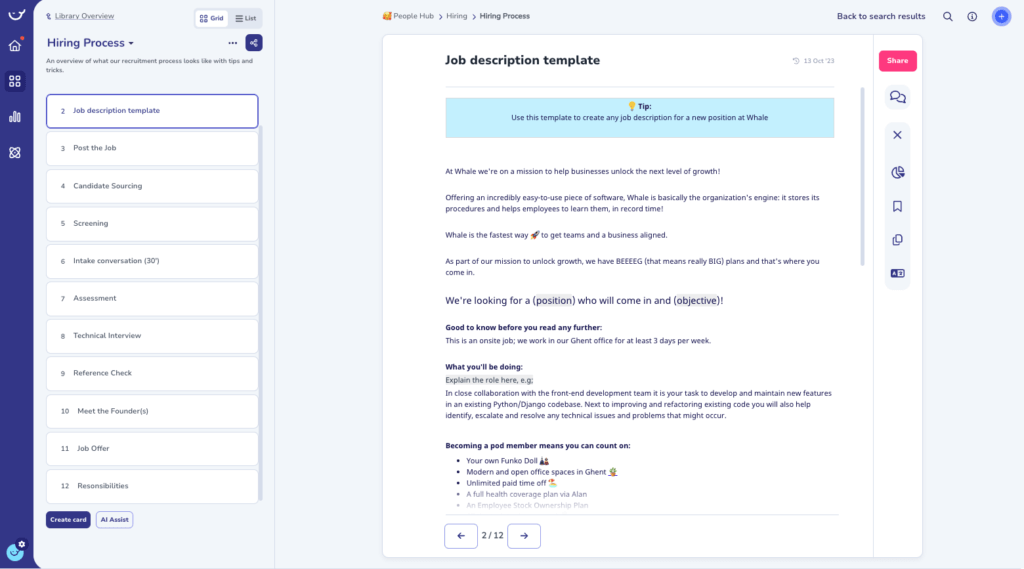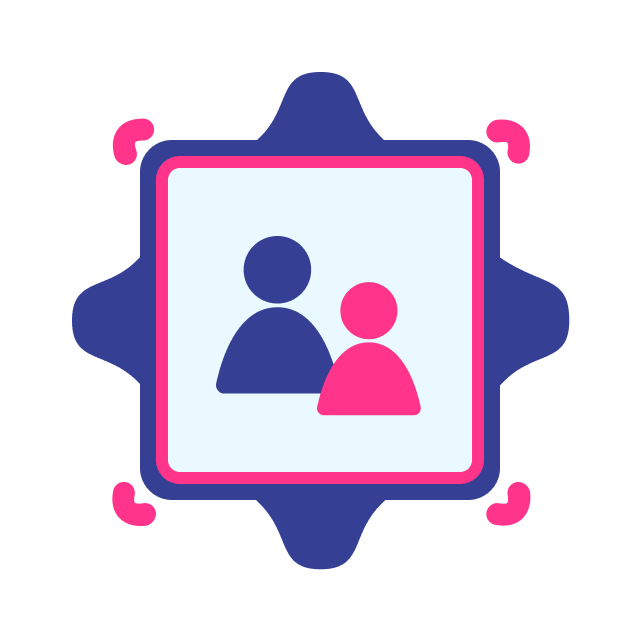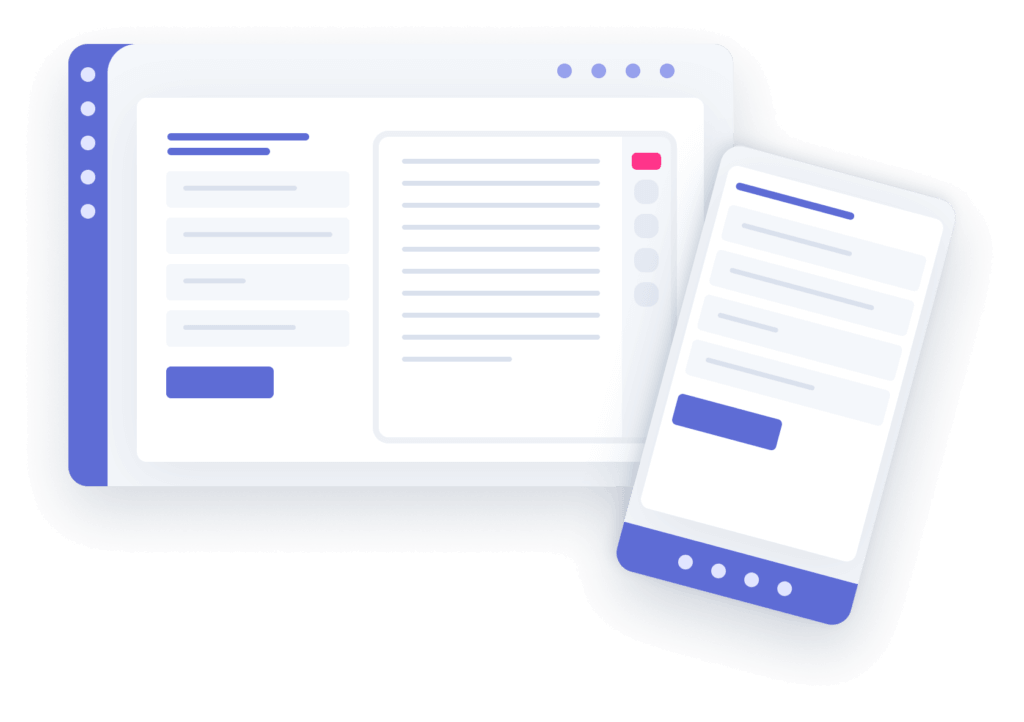
Click image for HQ version
What is a job description (JD)?
A job description is a detailed document that outlines the responsibilities, requirements, and qualifications needed for a specific role within a company. More than that, it’s an invitation to top talent to join your company and, once they do, to have absolute clarity in their role.
Our job description template serves as a vital tool in the hiring process, providing clarity for employers and potential candidates. Detailing the expectations and scope of a job helps ensure that both parties are aligned and on the same page from the start.
The benefits of using a job description template
Using a job description template streamlines the hiring process and offers several advantages:
- Consistency: Templates ensure that all job descriptions across the organization maintain a consistent format and level of detail.
- Efficiency: Templates save time by providing a pre-structured format, allowing hiring managers to focus on the specifics of the role rather than the structure of the document.
- Accuracy: Templates can help reduce the risk of missing important information, ensuring all necessary elements are included.
- Compliance: A well-crafted job description can help ensure compliance with labor laws and regulations by clearly defining job duties and qualifications.
Why do we need a job description?
According to a study by LinkedIn, companies with clear and detailed job descriptions experience a 30% reduction in employee turnover. This statistic highlights the importance of well-crafted job descriptions in attracting and retaining top talent.
Creating a job description might seem like a time-consuming task, but its importance cannot be overstated.
Here are key reasons why you need one:
Attracting the Right Candidates
A clear and detailed job description helps attract candidates who are truly suited for the role. It acts as a filter, drawing in those who meet the qualifications and deterring those who do not.
Setting Clear Expectations
A job description sets clear expectations for what the role entails, helping to avoid misunderstandings and ensure that employees know what is expected of them.
Performance Management
Job descriptions serve as a reference point for evaluating employee performance, providing a basis for feedback and performance reviews.
Legal Protection
Detailed job descriptions can protect your company from potential legal issues by clearly defining the roles and responsibilities of employees.
Use our templates to fast-track your documentation
Customize this template and 100s of others for free in Whale, the fastest way to get your team aligned.
Key Elements of a Job Description
An effective job description should include the following key elements:
- Job Title: Clearly state the title of the position.
- Summary: Provide a brief overview of the role and its purpose within the organization.
- Duties and Responsibilities: List the primary tasks and responsibilities associated with the role.
- Qualifications: Outline the necessary qualifications, including education, experience, skills, and certifications.
- Working Conditions: Describe the working environment and any physical requirements or special conditions.
- Diversity statement: Where does your company stand on diversity? This is a point you should articulate in your job description.
- Salary and Benefits: Provide information on compensation and benefits, if applicable.
- Reporting Structure: Indicate who the role reports to and any direct reports.
- Location: Specify where the job is based.
PS Remember to use clear and engaging language, highlight the role’s impact, and emphasize the company culture. Including specific examples of responsibilities and achievements can also make the description more compelling.
What helps a job description stand out?
There are the essential elements of a job description template, such as those above, and then there’s something special that helps it stand out.
Why would someone want to work for your company?
Here are a few additional elements that can help your job description stand out;
- Brand it! The days of boring old Word document job descriptions are out. Brand your job description so that the reader gets a feel of your brand.
- Focus on the reader. Tell the reader what they can expect in terms of employee experience if they continue the journey with your brand.
- Share your culture. What differentiates you? What values will make someone take notice and say, “I really want to work for or with that company?”
- Get social. Share your social media links to invite the reader to get to know you. Remember, every person is a chance for your brand and company personality to be recognized.
- Get creative. Add visuals or video to your job description. It’s that extra touch that’ll go a long way.
Real Examples of Successful Job Descriptions
- Google: Google’s hiring process is seamless, from its job descriptions, which are known for being clear, concise, and engaging, to its employee onboarding. Its focus on the role’s impact on the company and its mission helps attract the world’s best talent.
- Airbnb: Airbnb’s job descriptions emphasize the company culture and the role’s contribution to the company’s goals. They are detailed yet easy to read, ensuring potential candidates understand what is expected.
To illustrate the power of effective job descriptions, let’s look at a few examples from well-known companies:
Zappos: Zappos, who we’ve previously cited for great work in their employee handbook, does a great job of creating job descriptions. Each job description includes unique elements in their job descriptions, such as a cultural fit assessment. This helps ensure that new hires align with the company’s core values.
Example of a sales consultant job description
📝 Job brief
We are looking for a talented sales consultant to monitor and analyze our sales department performance and suggest new strategies.
Our ideal candidate should be able to use statistical analysis software and provide reports on sales and marketing metrics. You will collaborate with the sales team and the marketing department to achieve business goals.
Ultimately, you should be able to improve sales and increase profits.
💼 Responsibilities
- Learn the products and services offered, including the sales terms (e.g. special features, return and warranty policies)
- Set targets for the sales department
- Collaborate with the marketing department to prepare common strategies
- Monitor sales numbers and marketing metrics
- Calculate business trends, like monthly sales rates
- Analyze market trends
- Monitor competition and follow current developments
- Ensure sales team is up-to-date with business targets
- Motivate sales team to achieve great results
- Find prospective customers and new target segments
- Compile sales scripts and objection handling scripts
☑️ Requirements
- Proven work experience as a sales consultant
- In-depth knowledge of statistical analysis software like SPSS or SAS
- Familiarity with CRM programs
- Ability to gather and interpret data
- Organizational and analytical skills
- Communication skills
- BS degree in Marketing or a related field
Who Uses a job description?
Job descriptions are used by a variety of stakeholders within an organization:
- Human Resources: HR Managers facilitate recruitment, performance management, and compliance with labor laws.
- Hiring Managers: Hiring managers rely on JD’s to identify the right candidates and set clear expectations for new hires.
- Employees: Helps current employees understand their responsibilities and evaluate their performance.
- Recruiters: External recruiters use job descriptions to find and attract suitable candidates for open positions.
Bottom line?
Using these tips and examples, businesses can create effective job descriptions that attract the right candidates and support the organization’s growth and success.
Remember, a well-crafted job description is an investment in your company’s future, helping to build a strong, capable, and motivated workforce.
FAQs about job descriptions
What should I include in a job description?
Include the job title, summary, duties and responsibilities, qualifications, working conditions, salary and benefits, reporting structure, and location.
Can a job description help with employee retention?
Yes, clear job descriptions set expectations and help employees understand their roles, which can lead to higher job satisfaction and retention.
Are job descriptions legally required?
While not always legally required, job descriptions can help ensure compliance with labor laws and protect against potential legal issues.
Use our templates to fast-track your documentation
Customize this template and 100s of others for free in Whale, the fastest way to get your team aligned.




